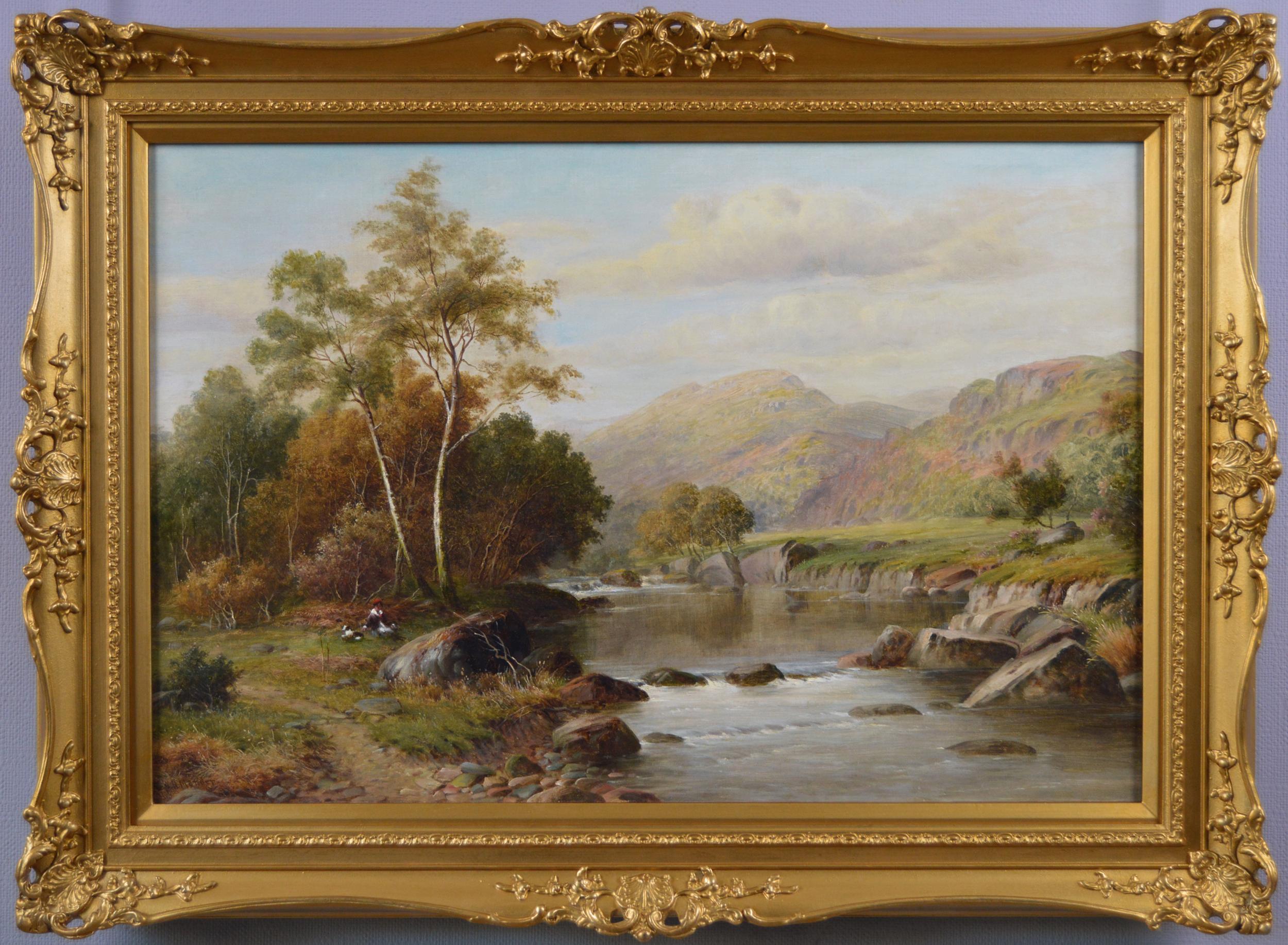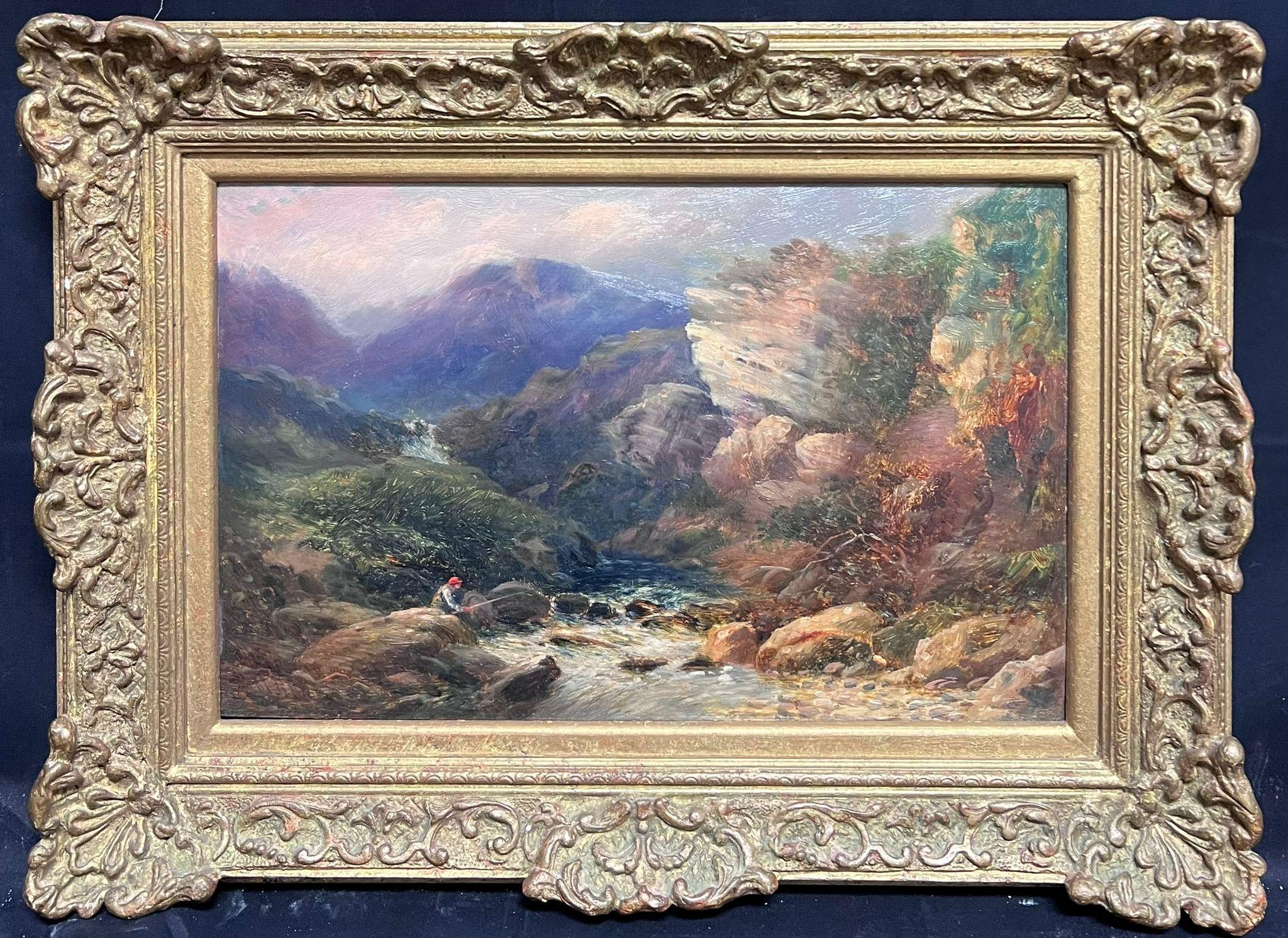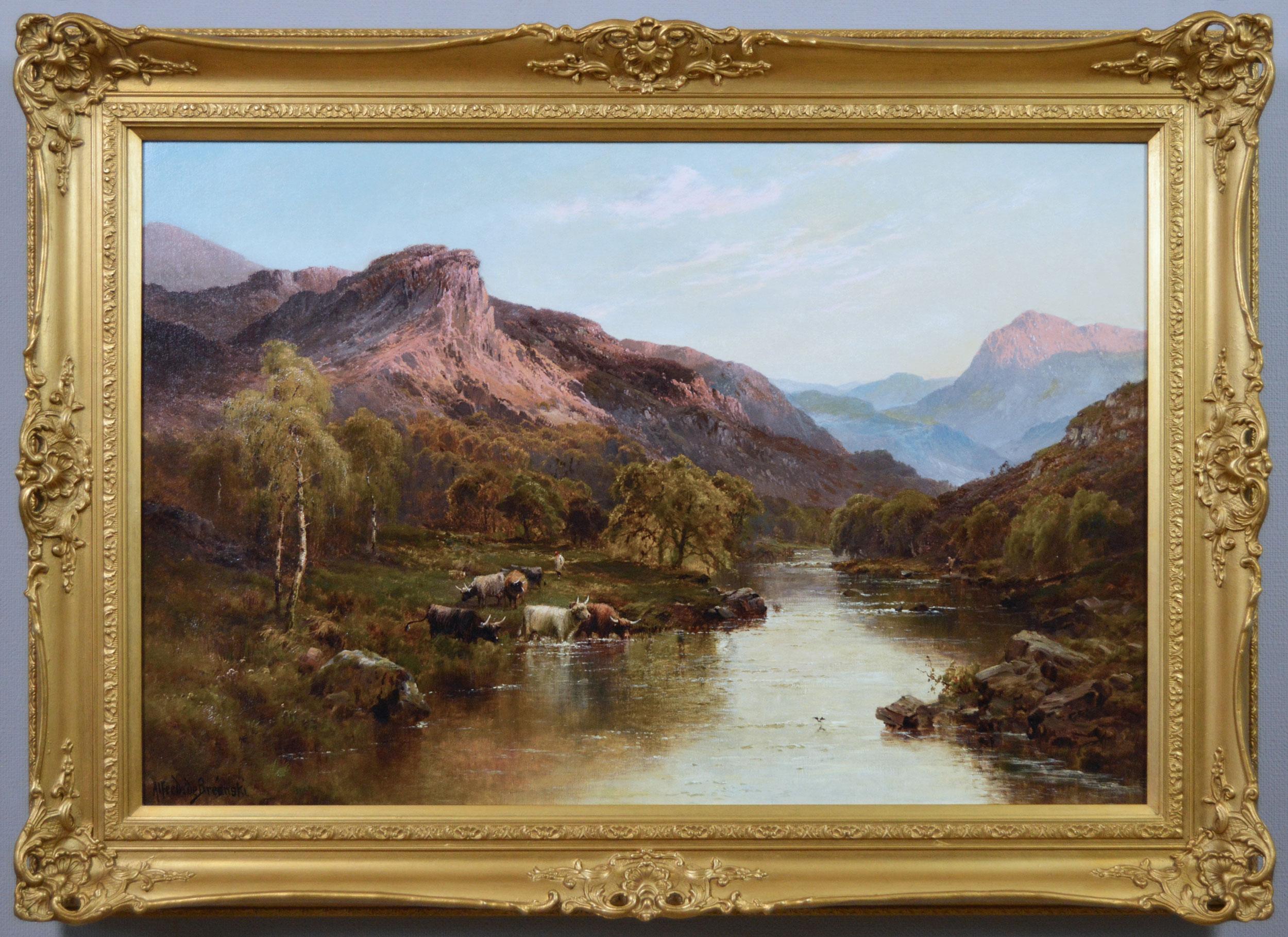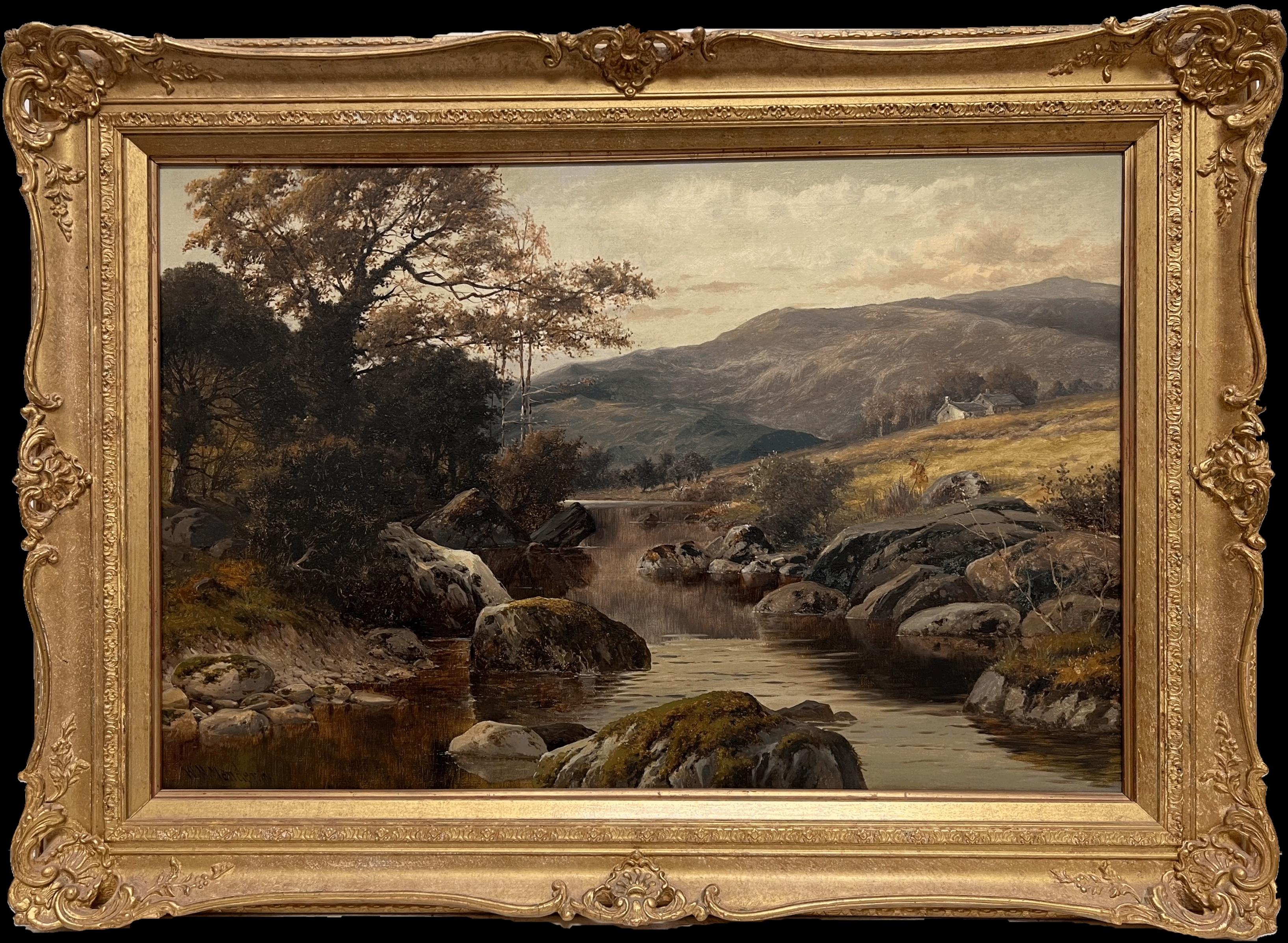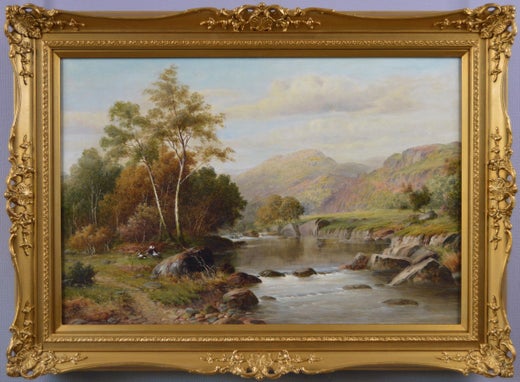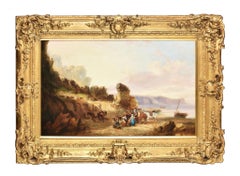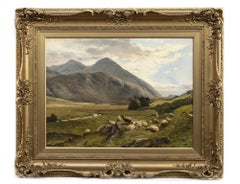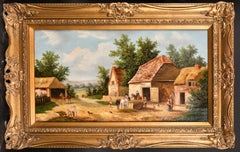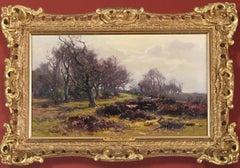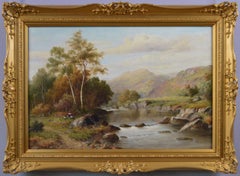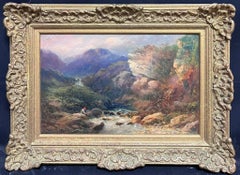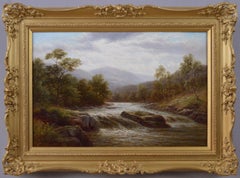Items Similar to The Mill, Dolgellau, Wales , William Henry Mander 19th century oil painting
Want more images or videos?
Request additional images or videos from the seller
1 of 9
William Henry ManderThe Mill, Dolgellau, Wales , William Henry Mander 19th century oil painting
$5,210.38
£3,800
€4,431.86
CA$7,134.80
A$7,932.93
CHF 4,142.14
MX$96,563.02
NOK 52,851.85
SEK 49,519.66
DKK 33,075.78
Shipping
Retrieving quote...The 1stDibs Promise:
Authenticity Guarantee,
Money-Back Guarantee,
24-Hour Cancellation
About the Item
The Mill, Dolgellau wales William Henry Mander 19th century oil painting
A fine oil on canvas painting of The Mill, Dolgellau, by the renowned artist William Henry Mander
Dolgellau is a town and community in Gwynedd, north-west Wales, lying on the River Wnion, a tributary of the River Mawddach. It was the traditional county town of the historic county of Merionethshire until the county of Gwynedd was created in 1974. Mandeer was so taken with this place that he lived here for a while,
Dating from the late 19th century/ early 20th century. The painting is signed lower left and mounted in leaf cast gilt frame.
The size is 40cm high 60cm wide whilst overall the size is 83 cm x 63 cm
In good condition has been fully cleaned and re varnished, the canvas has been re-lined and the frame is in good order. We have viewed this with a black light and can see no over painting
William Henry Mander was a landscape artist from Birmingham. He also lived in North Wales, Lincoln and Sheffield.
Mander often painted views of the Midlands and North Wales.
Mander had a naturalistic style his paintings also often featured cottages and figures engaged in activities such as fishing.
William Henry Mander exhibited regularly at the RBSA, the Royal Cambrian Academy and the Royal Hibernian Academy.
- Creator:William Henry Mander (1850 - 1932, British)
- Dimensions:Height: 24.81 in (63 cm)Width: 32.68 in (83 cm)
- Medium:
- Movement & Style:
- Period:
- Condition:
- Gallery Location:York, GB
- Reference Number:1stDibs: LU1800214818792
William Henry Mander
William Henry Mander was one of the principal artists of the late 19th century Birmingham School of landscape artists. Like many of his contemporaries, he became fascinated by the wild beauty of North Wales and lived there from 1899–1906. Between 1881–1914, Mander exhibited 122 works at the Royal Birmingham Society of Artists, 7 paintings at the Royal Cambrian Academy and 14 at the Royal Hibernian Academy.
About the Seller
5.0
Vetted Professional Seller
Every seller passes strict standards for authenticity and reliability
Established in 1991
1stDibs seller since 2022
23 sales on 1stDibs
- ShippingRetrieving quote...Shipping from: York, United Kingdom
- Return Policy
Authenticity Guarantee
In the unlikely event there’s an issue with an item’s authenticity, contact us within 1 year for a full refund. DetailsMoney-Back Guarantee
If your item is not as described, is damaged in transit, or does not arrive, contact us within 7 days for a full refund. Details24-Hour Cancellation
You have a 24-hour grace period in which to reconsider your purchase, with no questions asked.Vetted Professional Sellers
Our world-class sellers must adhere to strict standards for service and quality, maintaining the integrity of our listings.Price-Match Guarantee
If you find that a seller listed the same item for a lower price elsewhere, we’ll match it.Trusted Global Delivery
Our best-in-class carrier network provides specialized shipping options worldwide, including custom delivery.More From This Seller
View All19th century oil Devon coastal scene William Shayer Snr (Circle of)
By WILLIAM SHAYER SENIOR (1787-1879)
Located in York, GB
19th century oil Devon coastal scene William Shayer Snr (Circle of)
A very attractive oil on canvas of cockle gatherers on the Devon coast
The painting depicts a busy scene with people gathering their cockles with horses/donkeys laden with baskets ready to take to market.
The painting Bears signature, also inscribed and dated 1833 (lower right)
The size overall is 95 x 130cm whilst the image is 64 x 104cm (25 x 40¾ in.)
Housed in the original heavy gilt frame
Provenance: The property of a lady and gentleman , removed from a Cheshire country house
William Shayer (1787–1879) was an English landscape painter and figure painter who became prominent during the Victorian era.
A self-taught artist, who began by painting decorations on rush-bottom chairs. He moved on to painting carriages in the town of Guildford, after which he started doing heraldic painting...
Category
19th Century Old Masters Figurative Paintings
Materials
Oil
$3,839 Sale Price
20% Off
Free Shipping
BEN MORE, Auchlyne, oil , by Frederick Richard Lee & Thomas Sidney Cooper
Located in York, GB
BEN MORE FROM AUCHLYNE ROAD oil, by Frederick Richard Lee & Thomas Sidney Cooper
A beautiful 19th century landscape painting of the Scottish mountain (Munro) by the renowned artists Frederick Lee & Thomas Sidney Cooper
The painting is an oil on board, signed by both artists and dated 1854.Housed in a gilt frame.
The image size is 47cm x 62cm, whilst overall the size is 69cm x 85 cm
The painting is in very good condition, having had a light clean. There is some slight crazing to the sky section as to be expected with age, ( see photo close ups with flash) the frame is also in very good condition.
There is a handwritten label verso which reads
Note: According to Cooper, it was during a visit to Lee in Devon that a mutual decision was made to '...paint some pictures conjointly'. Lee was to paint the landscape first and Cooper to introduce the animals - and, at Lee's insistence, to handle the financial arrangements. In the late 1840s both artists were at the height of their popularity and their exhibited collaborations in the Dutch tradition created a 'great sensation' at the Royal Academy when they first appeared.
Prince Albert commented that they had '...caused a new want among patrons' and pronounced them 'the Beaumont and Fletcher...
Category
Mid-19th Century Old Masters Landscape Paintings
Materials
Oil
Georgina Lara 19th century oil painting landscape farm scene
By Georgina Lara
Located in York, GB
fine landscape oil painting of a farmyard scene by Georgina Lara (act.1840-1880) British.
Oil on canvas,housed in a gilt frame. Signed, and inscribed on a label verso,
The overall si...
Category
19th Century English School Animal Paintings
Materials
Oil
New Forest, Hampshire, 19th century, landscape oil, by Frederick Golden Short
By Frederick Golden Short
Located in York, GB
New Forest,Hampshire, 19th century,landscape oil, by Frederick Golden Short
A fine small framed landscape oil painting on canvas o...
Category
19th Century Old Masters Landscape Paintings
Materials
Oil
William sidney cooper, Cows by a river 19th century landscape oil
By William Sidney Cooper
Located in York, GB
A fine framed oil on canvas painting by the renowned artist William Sidney coope.Signed and dated 91 lower left.
This painting depicts 3 cows resting by a river, a village with hous...
Category
19th Century Old Masters Landscape Paintings
Materials
Oil
19th century landscape village scene horses, animals inn by georgina lara
By Georgina Lara
Located in York, GB
A very fine village scene depicting An English Village with figures, animals, horses, and cart by an Inn,
oil on canvas, indistinctly signed,G Lara , lower left
The size being 51cm x 31cm whilst overall being 66 cm x 47cm
in excellent ready to hang condition
Georgina Lara was also known as Edwina Lara ,she was a London painter of rustic farmyard and village scenes. Her work is extremely similar to Edward Masters who also went by the name of William Masters...
Category
19th Century Old Masters Figurative Paintings
Materials
Oil
You May Also Like
19th Century Welsh landscape oil painting of the river Mawddach
By William Henry Mander
Located in Nr Broadway, Worcestershire
William Mander
British, (1846-1914)
On the River Mawddach, Dolgellau, North Wales
Oil on canvas, signed & further inscribed & signed verso
Image size: 19.5 inches x 29.5 inches
Size...
Category
19th Century Landscape Paintings
Materials
Oil, Canvas
An Undershot Watermill - 19th Century Victorian Oil Painting of North Wales
Located in Gerrards Cross, GB
‘An Undershot Mill, North Wales’ by William E. Harris (1854-1934). The painting is signed by the artist and presented in a newly commissioned bespoke gold metal leaf frame.
A native...
Category
Late 19th Century Victorian Landscape Paintings
Materials
Oil
Victorian Oil Painting Welsh Mountain Landscape with Stream & Figure Fishing
Located in Cirencester, Gloucestershire
Mountain Landscape, Betws-y-Coed Wales
by Thomas Morris Ash (British 1851-1935)
signed and inscribed verso
Oil painting on board, framed
Framed: 14 x 19 inches
Board: 10.5 x 15.5 inc...
Category
Late 19th Century Victorian Landscape Paintings
Materials
Oil
19th Century landscape oil painting of a Welsh river
By William Mellor
Located in Nr Broadway, Worcestershire
William Mellor
British, (1851-1931)
On the Llugwy, North Wales
Oil on canvas, signed & further inscribed verso
Image size: 15.5 inches x 23.5 inches
Size including frame: 22.5 inches x 30.5 inches
A pleasing landscape painting of the River Llugwy in North Wales by William Mellor. Sheep can be seen grazing on the bank to the right as the river flows over a rock formation. Beyond is the stunning mountainous backdrop of Capel Curig.
William Mellor was a landscape painter who was born in Barnsley, Yorkshire in 1851, the son of Joseph Mellor, an artist and Mary Mellor. Initially, he was employed as a loom turner in the weaving industry before becoming a professional artist. He would have received tuition from his father who clearly influenced his style and subject matter.
In 1876, he married Mary Elizabeth Watson...
Category
19th Century Landscape Paintings
Materials
Canvas, Oil
19th Century Welsh river landscape oil painting near Betws-y-Coed
By Alfred de Breanski Sr.
Located in Nr Broadway, Worcestershire
Alfred de Breanski Snr
British, (1852-1928)
Near the Fairy Glen Betws-y-Coed
Oil on canvas, signed & transcribed verso
Image size: 23.5 inches x 35.5 inches
Size including frame: 31 ...
Category
19th Century Victorian Landscape Paintings
Materials
Canvas, Oil
Fine 1890's British Victorian Signed Welsh Landscape Oil Painting Angler River
Located in Cirencester, Gloucestershire
"On the Eder"
by William Herny Mander (British, 1850 - 1922) *see notes below
signed and dated 91'
titled verso
oil on canvas, framed in ornate swept gilt frame
framed: 26 x 36 inche...
Category
Late 19th Century Victorian Landscape Paintings
Materials
Oil
More Ways To Browse
Antique Fishing Line
Edward Hill
Norman Black Paintings
Robert E Wells
Docked Boat Oil Painting
Mediterranean Village
Mid Century Paris Street Scene
Museum Banner
Pont Des Arts
Tableau De
Used Garden Pond
California Vista
Marsh Scene Paintings
Umbrella On Beach
Midcentury And Detroit
Pastel Vintage Flower Painting
Vermont Impressionist Paintings
Autumn Mountains
